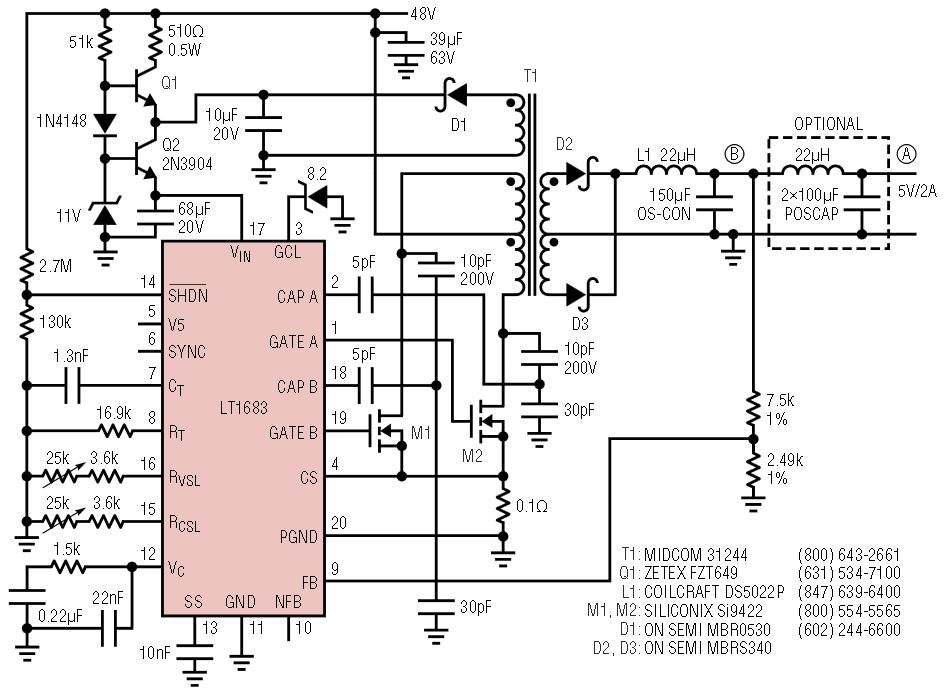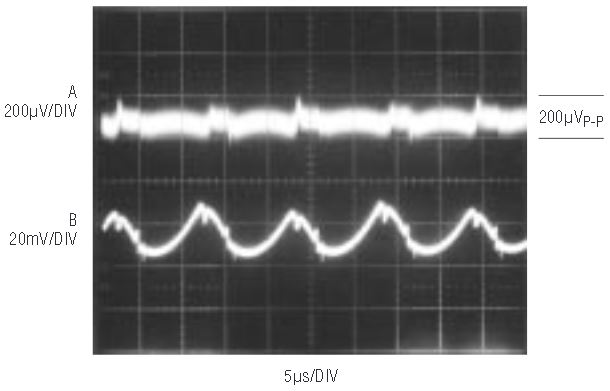Two New Switching Regulators Deliver Both Power and Ultralow Noise
Two New Switching Regulators Deliver Both Power and Ultralow Noise
Sep 1 2001
Introduction
Traditionally, when designers required a very low noise power supply, they would avoid DC/DC switchers because of their notorious reputation for generating high frequency harmonics. If they did use a switcher, careful attention would be required for board layout, shielding and the judicious use of filtering elements. The LT1683 and LT1738 are new switching regulator controllers that create a DC/DC switching supply with significantly lower conducted and radiated electromagnetic interference (EMI). These controllers reduce EMI at its source by controlling the current and voltage slew rates of the main switches. A robust DC/DC converter for use in noise-sensitive applications can be built with confidence.
The LT1683 and LT1738 make use of a patented dual control loop method that allows for control of both the output switch voltage slew rate and the output switch current slew rate. Bringing these slew rates under control eliminates the source of much of the high frequency harmonic energy in both the output voltage and in the input current; thus, less filtering is needed. The slew rates are user adjustable so that an optimal trade-off between noise and converter efficiency can be made. Typically, the optimal setting requires a loss of efficiency of only a few percent.
The LT1683, with two external MOSFET switches, is designed for use in a push-pull topology, whereas the LT1738 has a single external MOSFET for single-switch topologies. Because the switches are external, the user has complete control over voltage and current ratings of the supply.
The Magic of Slew Control
Analyzing the Fourier components of a square wave signal shows that the harmonic peaks roll off at 20dB/dec starting at the fundamental frequency. If the edges of that square wave are slewed so that it is trapezoidal, a second 20dB/dec roll-off at 1/tSLEW results, where tSLEW is the time it takes for the waveform transition.
In a switch-mode power supply, most of the noise is generated because of the switching action of the power switch. For efficiency these transitions are generally made as abrupt as possible, but slewing these edges allows for a great reduction of noise at a modest loss of efficiency. So the challenge is how to apply this to both the switch voltage and switch current.
In a normal switching cycle with an inductive load, the switch will turn on, current will rise until the switch diverts current from the inductor and then the voltage will fall. Therefore, we wish to slew the current and then gracefully switch over to slewing the voltage. When the switch turns off, the reverse should happen.
The LT1683 and LT1738 employ dual feedback loops to handle the slew control. Figure 1 shows symbolically how a single channel looks. The voltage slew control is a simple integrator using the external cap, CV, and a charging or discharging current, IVSL, based on a user-defined external resistor, RVSL.

Figure 1. LT1683/LT1738 slew control (one channel).
The current slew control is derived in the following manner. The voltage developed across the sense resistor is amplified and differentiated via an internal capacitor, CC. Thus, the current in CC is proportional to dI/dt. That current is limited to a value, ICSL, based on a user-defined external resistor, RCSL. The magnitude of the current in CC is translated to a current proportional to IVSL and is applied to the integrating node (Cap pin) to control the switch. In this manner the slew rates are both regulated and linked to provide quick and efficient on and off transitions.
Ultralow Noise 48V to 5V Converter
Figure 2 shows the schematic of a converter using the LT1683 in a push-pull forward converter topology. The LT1683 contains all the control circuitry for the converter: oscillator, error amp, gate drivers and protection circuitry. The capacitor divider networks from the drains to Cap A and Cap B provides for an effective 0.33pF capacitor that is used for the voltage slew rate feedback. The current slew feedback occurs internal to the LT1683 and uses the CS voltage as its feedback (switch current).

Figure 2. LT1683 push-pull converter.
The push-pull topology is desirable for low noise switchers because it draws current more continuously from the input, thus reducing conducted emissions.
The output noise of the converter is shown in Figure 3. The bottom trace is the output voltage of the regulator. The noise is dominated by the fundamental frequency of the switcher. When this component is further filtered out by the added filter, it is apparent how quiet the switcher is—the residual noise is a miniscule 200µVP-P at a 2A output (bandwidth = 100MHz).

Figure 3. 5V output noise for Figure 2’s circuit.
The LT1683 has many protection features. First, the SHDN pin provides the supply with undervoltage lockout, ensuring that the input is up and running before the converter is allowed to start. In addition, the GCL pin prevents excessive gate voltage on the MOSFET and prevents the MOSFETs from turning on without sufficient gate voltage. Excessive switch current will be detected at the CS pin and the MOSFETs will be turned off. Because of the voltage slew control, clamps or snubbers on the MOSFET drains are eliminated and switch ringing amplitude and duration are reduced by more than 80%.
Ultralow Noise 5V to 12V Boost Converter
Figure 4 shows a 5V to 12V/1A boost converter using the LT1738. The single switch provides a simpler solution at the expense of slightly higher noise. Figure 5 shows noise at the output voltage at 1A. It is a very low 400µVP-P.

Figure 4. 5V to 12V/1A boost converter using the LT1738.

Figure 5. 12V output noise for Figure 4’s circuit (bandwidth = 100MHz).
Ultralow Noise 30W Offline Supply
Figure 6 shows the flexibility of having external switches. The circuit is an AC line (90VAC to 264VAV) to 12V/2.5A converter using the LT1738 and a single high voltage MOSFET. The basic topology is a flyback converter, which, in conjunction with the optoisolator, provides for complete electrical isolation of the output. An overwinding coil on the transformer provides the supply voltage to the part.

Figure 6. Ultralow noise 30W offline power supply.
An input filter is used to attenuate the low frequency harmonics so the supply can pass FCC Class B regulations. The LT1738 reduces the high frequency harmonics and EMI noise components, eliminating the need for the grounded caps on the input filter.
Conclusion
Two new controllers have been created that allow designers to confidently tackle ultralow noise applications. The LT1683 and LT1738 not only provide normal controller functions but also regulate the main components of EMI in a switcher, thus easily reducing output noise. DC/DC converters can now be used in application areas such as precision instrumentation and noise-sensitive wideband communication equipment without the uncertain noise implications associated with normal converter design solutions.
About the Authors
Related to this Article
Products
PRODUCTION
Slew Rate Controlled Ultralow Noise DC/DC Controller
PRODUCTION
Slew Rate Controlled Ultralow Noise Push-Pull DC/DC Controller




















